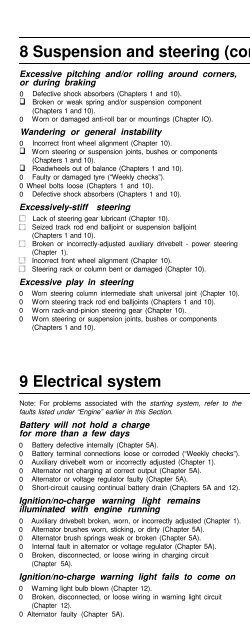Contents - Volkspage
Contents - Volkspage
Contents - Volkspage
Create successful ePaper yourself
Turn your PDF publications into a flip-book with our unique Google optimized e-Paper software.
8 Suspension and steering (continued)<br />
Fault finding REF.17<br />
Excessive pitching and/or rolling around corners,<br />
or during braking<br />
0 Defective shock absorbers (Chapters 1 and 10).<br />
q Broken or weak spring and/or suspension component<br />
(Chapters 1 and 10).<br />
0 Worn or damaged anti-roll bar or mountings (Chapter IO).<br />
Wandering or general instability<br />
0 Incorrect front wheel alignment (Chapter 10).<br />
q Worn steering or suspension joints, bushes or components<br />
(Chapters 1 and 10).<br />
q Roadwheels out of balance (Chapters 1 and 10).<br />
0 Faulty or damaged tyre (“Weekly checks”).<br />
0 Wheel bolts loose (Chapters 1 and 10).<br />
0 Defective shock absorbers (Chapters 1 and 10).<br />
Excessively-stiff steering<br />
Lack of steering gear lubricant (Chapter 10).<br />
Seized track rod end balljoint or suspension balljoint<br />
(Chapters 1 and 10).<br />
Broken or incorrectly-adjusted auxiliary drivebelt - power steering<br />
(Chapter 1).<br />
Incorrect front wheel alignment (Chapter 10).<br />
Steering rack or column bent or damaged (Chapter 10).<br />
Excessive play in steering<br />
0 Worn steering column intermediate shaft universal joint (Chapter 10).<br />
0 Worn steering track rod end balljoints (Chapters 1 and 10).<br />
0 Worn rack-and-pinion steering gear (Chapter 10).<br />
0 Worn steering or suspension joints, bushes or components<br />
(Chapters 1 and 10).<br />
Lack of power assistance<br />
• Broken or incorrectly-adjusted auxiliary drivebelt (Chapter 1).<br />
q Incorrect power steering fluid level (“Weekly checks”).<br />
q Restriction in power steering fluid hoses (Chapter 1).<br />
0 Faulty power steering pump (Chapter 10).<br />
0 Faulty rack-and-pinion steering gear (Chapter 10).<br />
Tyre wear excessive<br />
Tyres worn on inside or outside edges<br />
0 Tyres under-inflated (wear on both edges) (“Weekly checks”).<br />
0 Incorrect camber or castor angles (wear on one edge only)<br />
(Chapter 10).<br />
q Worn steering or suspension joints, bushes or components<br />
(Chapters 1 and 10).<br />
0 Excessively-hard cornering.<br />
0 Accident damage.<br />
Tyre treads exhibit feathered edges<br />
q Incorrect toe setting (Chapter 10).<br />
Tyres worn in centre of tread<br />
0 Tyres over-inflated (“Weekly checks”).<br />
Tyres worn on inside and outside edges<br />
0 Tyres under-inflated (“Weekly checks”).<br />
Tyres worn unevenly<br />
0 Tyres/wheels out of balance (Chapter 1).<br />
q Excessive wheel or tyre run-out (Chapter 1).<br />
0 Worn shock absorbers (Chapters 1 and 10).<br />
0 Faulty tyre (“Weekly checks”).<br />
9 Electrical system<br />
Note: For problems associated with the starting system, refer to the<br />
faults listed under “Engine” earlier in this Section.<br />
Battery will not hold a charge<br />
for more than a few days<br />
0 Battery defective internally (Chapter 5A).<br />
0 Battery terminal connections loose or corroded (“Weekly checks”).<br />
0 Auxiliary drivebelt worn or incorrectly adjusted (Chapter 1).<br />
0 Alternator not charging at correct output (Chapter 5A).<br />
0 Alternator or voltage regulator faulty (Chapter 5A).<br />
0 Short-circuit causing continual battery drain (Chapters 5A and 12).<br />
Ignition/no-charge warning light remains<br />
illuminated with engine running<br />
0 Auxiliary drivebelt broken, worn, or incorrectly adjusted (Chapter 1).<br />
0 Alternator brushes worn, sticking, or dirty (Chapter 5A).<br />
0 Alternator brush springs weak or broken (Chapter 5A).<br />
0 Internal fault in alternator or voltage regulator (Chapter 5A).<br />
0 Broken, disconnected, or loose wiring in charging circuit<br />
(Chapter 5A).<br />
Ignition/no-charge warning light fails to come on<br />
0 Warning light bulb blown (Chapter 12).<br />
0 Broken, disconnected, or loose wiring in warning light circuit<br />
(Chapter 12).<br />
0 Alternator faulty (Chapter 5A).<br />
Lights inoperative<br />
0 Bulb blown (Chapter 12).<br />
0 Corrosion of bulb or bulbholder contacts (Chapter 12).<br />
0 Blown fuse (Chapter 12).<br />
0 Faulty relay (Chapter 12).<br />
0 Broken, loose, or disconnected wiring (Chapter 12).<br />
0 Faulty switch (Chapter 12).<br />
Instrument readings inaccurate or erratic<br />
Instrument readings increase with engine speed<br />
0 Faulty voltage regulator (Chapter 12).<br />
Fuel or temperature gauges give no reading<br />
0 Faulty gauge sender unit (Chapters 3 and 4A or 4B).<br />
0 Wiring open-circuit (Chapter 12).<br />
0 Faulty gauge (Chapter 12).<br />
Fuel or temperature gauges<br />
give continuous maximum reading<br />
0 Faulty gauge sender unit (Chapters 3 and 4A or 4B).<br />
0 Wiring short-circuit (Chapter 12).<br />
0 Faulty gauge (Chapter 12).

















